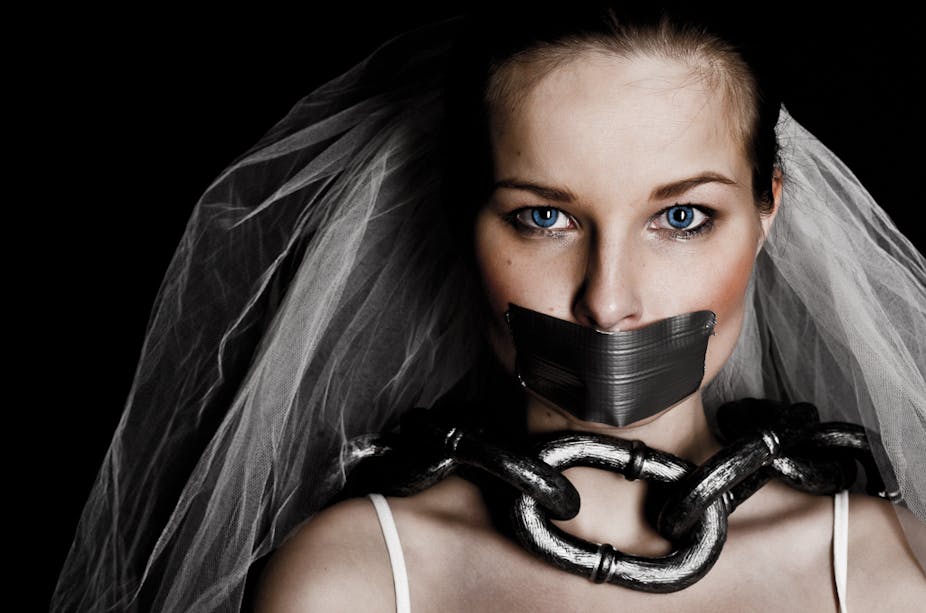This week’s episode of ABC’s typically male-dominated show Q&A involved a panel of women who were speakers at Sydney’s Festival of Dangerous Ideas (FODI). While the show presented far more conservative than radical ideas about gender, author and social commentator Jane Caro was provocative with her suggestion that marriage was historically “a form of prostitution”.
In answer to a question about sex workers, Caro explained that in the past marriage was in some respects a kind of economic exchange of women’s bodies. Conjugal rights and expectations about child-bearing were integral to the deal.
Caro was asking viewers to consider how some of the conditions of sex work, which are often used to demean women in the industry as lesser beings, have applied more broadly to women throughout history, especially prior to the 20th century.
Some viewers interpreted Caro’s comments to imply a connection between today’s stay-at-home mums and “prostitutes” and “whores”. Those angry reactions expose the continued denigration of women who sell sex, while the men who are their clients – around 15% of Australian men – do not become lessened by the interaction.
Caro subsequently published an article to calm the critical reaction and clarify that she was not referring to heterosexual marriages in contemporary society. But was she correct to say that marriage historically shared similarities with prostitution?
The recent history of love and marriage
We understand love as the basis for marriage. When we presume that a woman, in particular, is marrying for financial or personal gain, we apply terms such as “gold digger” to indicate disapproval. From Anna Nicole Smith wedding an 89-year-old billionaire to the union of Brynne Gordon to entrepreneur Geoffrey Edelsten, we condemn women who we cannot imagine have married solely for our idea of love.
Yet criticism of people who married without love dates back to at least the 18th century in Britain. And, perhaps surprisingly, several notable writers of the period explicitly compared such marriages to a form of prostitution.
Daniel Defoe, of Robinson Crusoe fame, wrote in Conjugal Lewdness or, Matrimonial Whoredom (1727) that:
He or She who, with that slight and superficial Affection, Ventures into the Matrimonial Vow, are to me little more than legal Prostitutes.
In 1790, the English writer Mary Wollstonecraft argued that for women to “marry for a support” was “legal prostitution”. Other British feminists made connections between the male dominance inherent in both institutions, as well as the ways in which both could “enslave” women’s bodies.
Though the notion of marriage as a strategy for financial or social gain, or merely survival, was being criticised in the 18th century, the absolute belief that love was a requirement for a marriage was still developing.
As Jennifer Phegley shows in her book Marriage and Courtship in Victorian England (2011), it was really only at the beginning of the 19th century that the notion of a “companionate marriage” was idealised. It took centuries for marriage to evolve from a transaction arranged by families to exchange status and wealth into an institution grounded in romantic love.

But the reality was that marriage in the Victorian period was still influenced by laws that meant women usually didn’t inherit property (it went to male heirs) and often, depending on their class status, were unable to work outside the home. Marriage, for many women, was a necessity to ensure that they would be housed and fed into old age.
The legal doctrine of coverture meant that marriage merged the husband and wife as one legal entity, effectively suspending the wife’s legal existence. Even if a woman was able to earn a wage or had inherited money, until the late 19th century, it automatically become her husband’s property.
Unless otherwise provided for by her family, a woman might be left destitute if her husband sought a divorce, or if she went through the difficult process of seeking one. (The 1857 Matrimonial Causes Act required a woman to prove both her husband’s adultery and that he had treated her cruelly, deserted her, or committed incest or bigamy.) Her legal rights to any of her children after divorce were also limited.
How was marriage like prostitution?
Many sex workers today emphasise the choice and agency involved in their employment. Historically, women from lower-class families who did not have sufficient means to provide for them had limited options for employment.
In comparison with low-paying menial work with long hours, prostitution could offer young women a greater income and degree of independence than other forms of work.
Both marriage and prostitution were among the limited options available to women to ensure that they could gain access to money through men, who controlled the vast majority of wealth and property. Within marriage, a woman’s freedoms were legally more constrained than those of an unmarried sex worker.
Social conditions and laws made it difficult for women to remove themselves from an unhappy marriage or from prostitution, which carried great moral stigma. With few other options available for economic survival, it was certainly the case that there were both married women and sex workers who were compelled to continue sexual relationships with men when they desired to do otherwise.
Ultimately, Caro’s comparison has a real historical basis. The facts of traditional marriage should not be forgotten as we continue to address the vestiges of sexism in a culture that was once grounded in the economic exchange of women.

